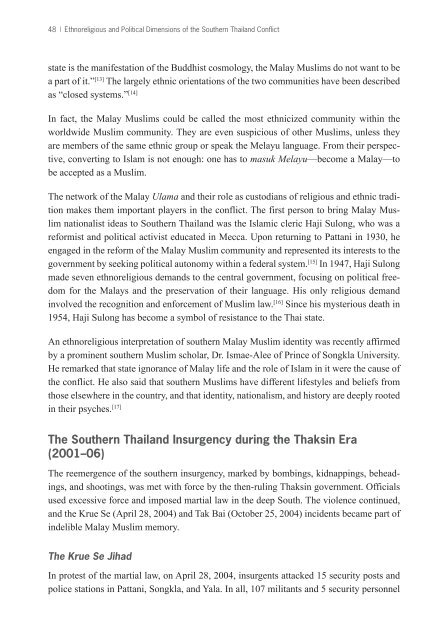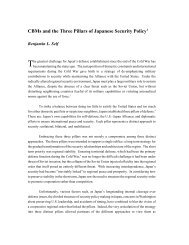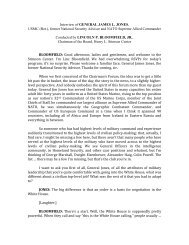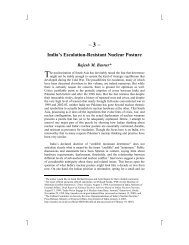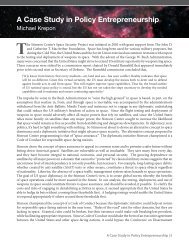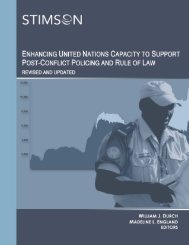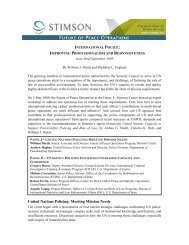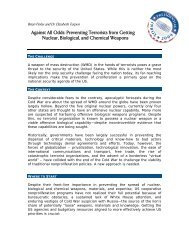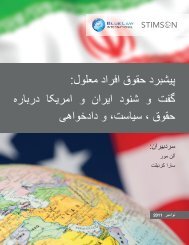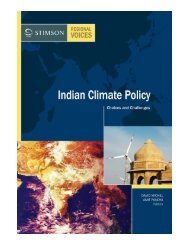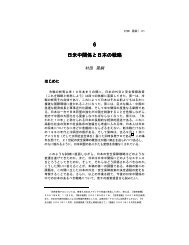Islam and Politics - The Stimson Center
Islam and Politics - The Stimson Center
Islam and Politics - The Stimson Center
Create successful ePaper yourself
Turn your PDF publications into a flip-book with our unique Google optimized e-Paper software.
48 | Ethnoreligious <strong>and</strong> Political Dimensions of the Southern Thail<strong>and</strong> Conflict<br />
state is the manifestation of the Buddhist cosmology, the Malay Muslims do not want to be<br />
a part of it.” [13] <strong>The</strong> largely ethnic orientations of the two communities have been described<br />
as “closed systems.” [14]<br />
In fact, the Malay Muslims could be called the most ethnicized community within the<br />
worldwide Muslim community. <strong>The</strong>y are even suspicious of other Muslims, unless they<br />
are members of the same ethnic group or speak the Melayu language. From their perspective,<br />
converting to <strong>Islam</strong> is not enough: one has to masuk Melayu—become a Malay—to<br />
be accepted as a Muslim.<br />
<strong>The</strong> network of the Malay Ulama <strong>and</strong> their role as custodians of religious <strong>and</strong> ethnic tradition<br />
makes them important players in the conflict. <strong>The</strong> first person to bring Malay Muslim<br />
nationalist ideas to Southern Thail<strong>and</strong> was the <strong>Islam</strong>ic cleric Haji Sulong, who was a<br />
reformist <strong>and</strong> political activist educated in Mecca. Upon returning to Pattani in 1930, he<br />
engaged in the reform of the Malay Muslim community <strong>and</strong> represented its interests to the<br />
government by seeking political autonomy within a federal system. [15] In 1947, Haji Sulong<br />
made seven ethnoreligious dem<strong>and</strong>s to the central government, focusing on political freedom<br />
for the Malays <strong>and</strong> the preservation of their language. His only religious dem<strong>and</strong><br />
involved the recognition <strong>and</strong> enforcement of Muslim law. [16] Since his mysterious death in<br />
1954, Haji Sulong has become a symbol of resistance to the Thai state.<br />
An ethnoreligious interpretation of southern Malay Muslim identity was recently affirmed<br />
by a prominent southern Muslim scholar, Dr. Ismae-Alee of Prince of Songkla University.<br />
He remarked that state ignorance of Malay life <strong>and</strong> the role of <strong>Islam</strong> in it were the cause of<br />
the conflict. He also said that southern Muslims have different lifestyles <strong>and</strong> beliefs from<br />
those elsewhere in the country, <strong>and</strong> that identity, nationalism, <strong>and</strong> history are deeply rooted<br />
in their psyches. [17]<br />
<strong>The</strong> Southern Thail<strong>and</strong> Insurgency during the Thaksin Era<br />
(2001–06)<br />
<strong>The</strong> reemergence of the southern insurgency, marked by bombings, kidnappings, beheadings,<br />
<strong>and</strong> shootings, was met with force by the then-ruling Thaksin government. Officials<br />
used excessive force <strong>and</strong> imposed martial law in the deep South. <strong>The</strong> violence continued,<br />
<strong>and</strong> the Krue Se (April 28, 2004) <strong>and</strong> Tak Bai (October 25, 2004) incidents became part of<br />
indelible Malay Muslim memory.<br />
<strong>The</strong> Krue Se Jihad<br />
In protest of the martial law, on April 28, 2004, insurgents attacked 15 security posts <strong>and</strong><br />
police stations in Pattani, Songkla, <strong>and</strong> Yala. In all, 107 militants <strong>and</strong> 5 security personnel


